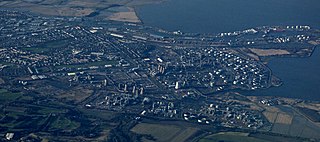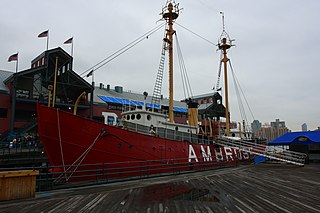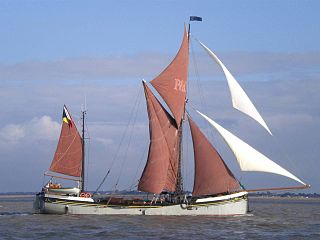
A paddle steamer is a steamship or steamboat powered by a steam engine that drives paddle wheels to propel the craft through the water. In antiquity, paddle wheelers followed the development of poles, oars and sails, where the first uses were wheelers driven by animals or humans.

Grangemouth is a town in the Falkirk council area, Scotland. Historically part of the county of Stirlingshire, the town lies in the Forth Valley, on the banks of the Firth of Forth, 3 miles (4.8 km) east of Falkirk, 5 miles (8.0 km) west of Bo'ness and 13 miles (20.9 km) south-east of Stirling. Grangemouth had a resident population of 17,906 according to the 2001 Census. Preliminary figures from the 2011 census reported the number as 17,373.

The PS Medway Queen is a paddle driven steamship, the only mobile estuary paddle steamer left in the United Kingdom. She was one of the "little ships of Dunkirk", making a record seven trips and rescuing 7,000 men in the evacuation of Dunkirk.

Eureka is a side-wheel paddle steamboat, built in 1890, which is now preserved at the San Francisco Maritime National Historical Park in San Francisco, California. Originally named Ukiah to commemorate the railway's recent extension into the City of Ukiah, the boat was built by the San Francisco and North Pacific Railroad Company at their Tiburon yard. Eureka has been designated a National Historic Landmark and was listed in the National Register of Historic Places on April 24, 1973.

The tall ship Elissa is a three-masted barque. She is based in Galveston, Texas, and is one of the oldest ships sailing today. Launched in 1877, she is now a museum ship at the Texas Seaport Museum. She was designated a National Historic Landmark in 1990. The Texas Legislature designated Elissa the official tall ship of Texas in 2005.

SS Nomadic is a former tender of the White Star Line, launched on 25 April 1911 in Belfast now on display in Belfast's Titanic Quarter. She was built to transfer passengers and mail to and from RMS Olympic and RMS Titanic. She is the only surviving vessel designed by Thomas Andrews who also designed those two ocean liners, and the only White Star Line vessel in existence today.

SS Explorer is one of the last surviving sea-going steam trawlers and is registered to Leith, the port of Edinburgh. She has been placed on the National Historic Ships Register and the SS Explorer Preservation Society is currently restoring her in the Edinburgh Dock, Leith.

The Zetland is the oldest surviving lifeboat in the world. It is currently in a free museum in Redcar, England. The name Zetland comes from the local Lord of Manor, the Marquess of Zetland. The Zetland is on the National Register of Historic Ships, as part of the National Historic Fleet.

Jumbo Kingdom consisted of the Jumbo Floating Restaurant and the adjacent Tai Pak Floating Restaurant, which were tourist attractions in Aberdeen South Typhoon Shelter, within Hong Kong's Aberdeen Harbour. During its 44 years of operation, over thirty million visitors visited Jumbo Kingdom, including Queen Elizabeth II, Jimmy Carter, Tom Cruise, Chow Yun Fat, and Gong Li. A subsidiary, Jumbo Kingdom Manila, operated in Manila Bay, Philippines, but closed after eight years. Jumbo Kingdom was part of Melco International Development Limited, a company listed on the Hong Kong Stock Exchange. It suspended operations in 2020 amidst the COVID-19 outbreak.

MV Balmoral is a vintage excursion ship owned by MV Balmoral Fund Ltd., a preservation charity. Her principal area of operation is the Bristol Channel, although she also operates day excursions to other parts of the United Kingdom. The Balmoral is included on the National Historic Ships register as part of the National Historic Fleet.
The Little Ships of Dunkirk were about 850 private boats that sailed from Ramsgate in England to Dunkirk in northern France between 26 May and 4 June 1940 as part of Operation Dynamo, helping to rescue more than 336,000 British, French, and other Allied soldiers who were trapped on the beaches at Dunkirk during the Second World War.

Henry Francis Greathead (1757–1818) was a pioneering rescue lifeboat builder from South Shields. Although Lionel Lukin had patented a lifeboat in 1785, Greathead successfully petitioned parliament in 1802 with the claim that he had invented a lifeboat in 1790, and he was awarded £1,200 for his trouble. Although his claims have been contested, he did build 31 boats, which saved very many lives, and succeeded in making the concept of a shore-based rescue lifeboat widely accepted.

M/V Mississippi is a United States Army Corps of Engineers (USACE) towboat operating on the Mississippi River. It is the largest diesel towboat on the river.

Aberdeen Harbour, rebranded as the Port of Aberdeen in 2022, is a sea port located in the city of Aberdeen on the east coast of Scotland. The port was first established in 1136 and has been continually redeveloped over the centuries to provide a base for significant fishing and ship building industries. Since the 1970s it has provided support to the offshore oil and gas industry operating in the North Sea and it is the main commercial port in the north east of Scotland.
MVSeymour Castle is a river boat sailing for Thames River Cruises of Reading, England as the MV Devon Belle. She is registered by National Historic Ships on the National Register of Historic Vessels, certificate number 1955, and is one of the surviving "Little ships of Dunkirk" from the Dunkirk evacuation in 1940.

ST Cervia was built in 1946 as a seagoing tug for use as a fleet auxiliary by Alexandra Hall & Company Ltd of Aberdeen, Scotland. Today she is a floating Museum still undergoing restoration in Ramsgate, Kent.

The United States Lightship LV-87/WAL-512 (Ambrose) is a riveted steel lightship built in 1907 and served at the Ambrose Channel lightship station from December 1, 1908, until 1932, and in other posts until her decommissioning in 1966. It is one of a small number of preserved American lightships, and now serves as a museum ship at the South Street Seaport Museum in southern Manhattan, New York City.

RNLB Lucy Lavers was an RNLI lifeboat which was on No. 2 station at Aldeburgh from 1940 until 1959 when she was placed in the reserve fleet until 1968 when she was retired. The Rescue Wooden Boats Charity is currently undertaking restoration of the vessel. The Lucy Lavers is entered in the National Historic Ships register and has the Certificate No 2206.

Will is a Thames sailing barge, built in Great Yarmouth by Fellows & Co in 1925. She is 97.6 ft (29.75 m) long, 23.1 ft (7.04 m) across and 9.6 ft (2.93 m) deep. Will Everard, as she was originally known, was commissioned as one of four steel barges; the largest ever built. She is a mulie, with a spritsail rigged mainmast, a topmast and a gaff-rigged mizzen. She has a flat bottom with leeboards as is customary for Thames sailing barges. As one of the last sailing cargo vessels to operate in UK waters she left trade in 1966. After a few years lying derelict, she was refitted and eventually entered into the service of P&O where she was used as a floating board room until 1999. This role in corporate hospitality continued and she now is fully engaged in private charter work. She currently operates out of the Pool of London from a base at Hermitage Community Moorings, Reeds Wharf and St Katherine Docks for cruises through London, the east coast and beyond.
Telford Parliamentary church also known as the Telford Kirks are a series of presbyterian churches in Scotland built with money voted from the parliament of the United Kingdom as a result of the Church of Scotland Act 1824 for a grant of £50,000, designed by the surveyor William Thomson and built by the Scottish stonemason and architect Thomas Telford. In total, 32 churches were built and many are still in use today. Others have been abandoned, e.g. at Stoer, while others were destroyed and rebuilt, e.g. at Tobermory, while others have been converted to dwellings.

















